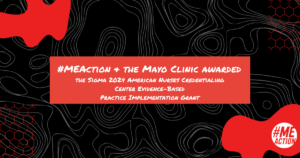Dane Cook is Professor of Kinesiology at the University of Wisconsin and Director of the March Center for Research in Exercise and Movement. He is also a member of the US. National Institute of Neurological Disorders and Stroke Council Working Group for ME/CFS Research Roster.
How did you get involved with the area of ME research?
My first exposure to this disease was during my post-doctoral fellowship in the New Jersey Chronic Fatigue Syndrome Center under the direction of Dr. Benjamin Natelson. I was conducting a brain imaging study of fibromyalgia and immediately became interested in the ME/CFS exercise studies that Dr. Natelson’s Center was conducting.
Can you tell us about your current research into ME?
My current research focuses on using exercise as a physiological challenge and determining how it affects central, autonomic and immune systems. These studies are meant to uncover pathophysiological mechanisms of disease maintenance and severity and are focused on the phenomenon of post-exertional malaise (PEM).
Post-exertional malaise (PEM) is a central feature of ME. Yet is poorly understood by many health professionals and the wider public. Can you sum up what PEM is?
First, PEM is poorly understood and poorly defined both clinically and in the literature. This is one of the challenges to studying this phenomenon. In our studies, we operationalize PEM as an increase in disease symptoms compared to a baseline condition. Further, we do not consider PEM to be a single symptom, but rather a constellation of symptoms that can become worse with mental or physical stress. Thus, we consider that PEM may present as an increase in one symptom (e.g., the person’s primary symptom of fatigue or other) or as a cluster of symptoms (e.g., pain, fatigue, and confusion). Finally, PEM can vary across time for an individual so it may present one way on one day and a different way on a different day. We think that this approach is consistent with the disease being both heterogeneous and that patients report that their symptoms can change over time. To sum it up in layman’s terms, PEM is worsening of the disease when a person with ME attempts to increase their physical and/or mental activities of daily living.
At NHS specialist clinics in the UK many ME patients are encouraged to undertake Graded Exercise Therapy. Yet numerous ME patient surveys reveal that large numbers of people get worse when undertaking Graded Exercise Therapy. Based on your years of research into PEM do you think that Graded Exercise Therapy is an appropriate treatment for ME patients?
This is a really important question and one that my lab has paid close attention to. On the one hand, physical exercise can clearly worsen symptoms in ME, particularly when it is moderate to intense. However, avoiding physical activity has also been shown to worsen disease over time. This is the proverbial catch-22 for the person with the disease. However, the bigger issue is the total misunderstanding of graded exercise therapy. In ME, graded exercise therapy has been siloed into a treatment that is based on the idea that ME is a disease of low fitness and that by increasing activity and increasing fitness that the person should get better. This is totally false and has resulted in the complete rejection of any form of physical therapy for ME. ME is of course NOT a disease of low fitness and there is a mountain of biological data to refute the notion that people suffer from ME because they are lazy.
However, physical activity and exercise therapy should not be rejected based on the misconception of the PACE trial. Many of the worlds top ME and ME/CFS clinicians use gentle physical activity as part of a multi modal treatment approach. Further, they do not use a one-size-fits-all approach, rather they individualize it to the patient, their disease severity and their daily symptom fluctuations. I’ll end with this, and I know I’m not giving you a yes or no answer, being physically active is much more than a treatment. By this I mean, that the consequences of avoiding activity are many (e.g. cardiovascular disease, risk of cancer, reduced mental health) and these can negatively impact ME and make the disease worse. However, we don’t yet know how to responsibly use physical activity for the good of the patient. I realize that there are some people with ME whose disease is too severe for any physical activity and they should not be forced into doing it. But, there are many for whom gentle activity may aid their treatment, and we need the research to figure out for whom activity is appropriate, for whom it is not and what amounts are most efficacious.
Can post-exertional malaise be objectively measured by scientists?
We are working on this question, but the answer is “not yet”. What we need here are studies that show a definite worsening of symptoms that relate to a biological abnormality, and that when we “fix” the biological abnormality the PEM is avoided. We have biological correlates of PEM (e.g. brain responses, metabolic exercise outcomes), but we don’t have any causal mechanisms as of yet.
How does post-exertional malaise affect the various symptoms of ME patients?
See my answer above for details, but basically we think that PEM is an exacerbation of the symptoms that define ME. Once we know the biology of PEM, this may change. For example, PEM may turn out to be an abnormal metabolic/immune response to physical activity and that this in turn leads to disease worsening.
In your opinion what needs to be done by public health authorities to bring about better health outcomes for people suffering from ME?
I have been involved in many government committees that have been tasked with these types of policy questions. The answer is many-fold and really requires a dedicated campaign for public awareness, physician education and significant investment in research. I have seen many positive changes over the years, but unfortunately, much more needs to be done on all of these fronts. Public awareness and research are painfully slow processes and we must keep these efforts going and not take steps backwards. Research dollars have been tough to come by, but at least here in the US, the National Institutes of Health is working towards a strategic approach. Hopefully, this will result in a road map for scientists to follow and we will uncover the mechanisms of the disease. Once mechanisms are discovered, public awareness campaigns will be re-invigorated and physician education will become a moral imperative.







1 thought on “Meet the Scientist: Dr. Dane Cook”
Myalgic Encephalomyelitis was deemed to be caused from some infection. Without proper pathology testing, no treatment protocol will be successful. This is the problem with western medicine that looks at symptoms and not the relationship of a total body system. My life changed when the cause was identified and then to proceed to treatment – traditional medicine combined with other nutritional and immune stimulation treatments – mostly it was my own research that helped change my life.
Comments are closed.